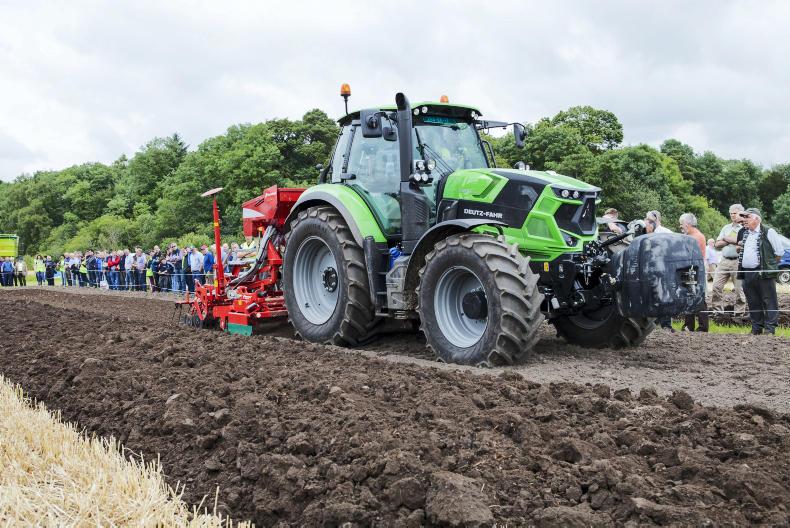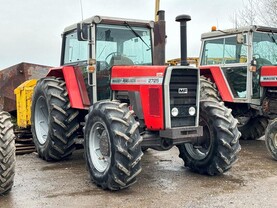Traffic, whether from animal or machine sources, can damage the soil’s structure resulting in restricted root growth, reduced water and nutrient availability and lower grass and crop yields.
Machinery, in particular, can impose huge loads on the soil, with total machine train loads often being 20t or more and individual axle loads in excess of 10t.
However, the tyres that carry that load can help to protect the soil by spreading the load over a greater area and reducing the strain on the soil. Tyre size has increased considerably in recent years – but has it increased enough?
Then and now
Today’s larger tractors are characterised by their bigger tyres. Some of them seem enormous, both in width and depth, but how do they compare in capacity terms given their weight and power?
On tillage farms in the early 1970s, tractors such as the Ford 4000 with 16.9/14-30 tyres were often used on seed drills. Today, tractors such as a Deutz-Fahr Agrotron 6185 undertake that drilling role with one-pass sowing units or similar, but are fitted with the much larger 650/65R38 tyres.
However, while these tyres have three times the air volume and three times the load capacity of the older 16.9R 30s, because the tractor weight and power is four times that of the 1970s tractor, the modern tractor is much poorer in terms of tyre capacity (Table 1). So the apparently large tyres are not big enough for today’s larger loads.
Todays’ heavyweights
A recent study of tillage machinery working in fields by Oak Park’s Brendan Burke showed the huge changes in machine weights and axle loads, particularly with mounted equipment.
Rear axle loads on tractors when ploughing varied from 6.5t with a four-furrow mounted plough to 11t with a 200kW tractor and six-furrow mounted plough. For one-pass sowing combinations, 3m units with 130kW tractors typically had axle loads close to 8t, but the largest 6m-wide mounted one-pass units operated by 240kW tractors have axle loads in excess of 12t (Figure 1).
All of these axle loads are capable of causing damage to the soil. Tyres play a crucial role in preventing damage from these loads.
Larger tyres spread the load over a greater surface area and reduce the ground pressure. But how do we know when a tyre is big enough? We can use larger tyres’ ability to carry loads at lower inflation pressure as a very good guide.
Ground pressure
Inflation pressure is a good guide to ground pressure, as it is the air within a tyre which supports the load. So can we reduce ground pressure by simply lowering inflation pressure? Yes, but only if we don’t go below the level of deflection allowed by the tyre manufacturer which is usually about 20%. Otherwise, the tyre will be damaged.
The level of tyre deflection allowed depends on the type of tyre carcase construction and the operating speed – less deflection is allowed at higher speeds. Many modern tractor tyres are designated as VF or IF. These tyres allow a greater level of deflection and for their size can carry a load at lower inflation pressure and reduced ground pressure.
What pressure should we target?
The ground pressure and inflation pressure target depends on soil conditions and, in particular, soil moisture. When ploughing, for example, tyres big enough to work at 1.0-bar pressure (15 psi) or less should be used, whereas when working on ploughed ground which is more easily damaged, larger tyres capable of operating at 0.8-bar pressure or less should be used.
Selecting the correct tyres
The tyre selection process is outlined in Table 2. Load and inflation tables are central to this process as they indicate the load that any tyre can carry at a particular inflation pressure and at certain forward speeds.
The impact of newer tyre technologies, which allow greater deflection (VF- and IF-rated tyres), are indicated by lower inflation pressures and lower gorund pressures for a given tyre size.
Do axle loads matter?
If large enough tyres are fitted, the same ground pressure can be achieved with a 10t load as with a 3t axle load, but is the effect on the soil the same?
Unfortunately, it is not quite the same, as while ground pressure will determine the level of tyre sinkage, greater axle loads at the same ground pressure tend to put more stress deeper into the soil. Therefore, even lower ground pressures should be targeted with heavier axle loads.
Big tractors
With big-tractor axle loads such as those of 250kW+ tractors and mounted equipment, it can be difficult to get tyres large enough to achieve low pressures without resulting in an excessive road width and, of course, they can be hugely expensive. But this is no excuse for using higher ground pressures; either large enough tyres should be fitted or smaller axle loads should be used.
The correct approach
Determine the target ground pressure/inflation pressure.Measure/estimate your axle load.Consider tyre diameter limitations (4wd ratio or mudguard clearance).Search for tyres that will carry that load using manufacturers’ load and inflation tables.Tyres play a crucial role in soil protection.Modern tractors’ standard tyres are often too small considering the axle loads being carried.Tyre technology is improving, allowing greater carcase deflection and lower ground pressure.Tyre choice should be based on axle load and desired ground pressure.Heavy axle loads create particular challenges and require even lower ground pressures.
Traffic, whether from animal or machine sources, can damage the soil’s structure resulting in restricted root growth, reduced water and nutrient availability and lower grass and crop yields.
Machinery, in particular, can impose huge loads on the soil, with total machine train loads often being 20t or more and individual axle loads in excess of 10t.
However, the tyres that carry that load can help to protect the soil by spreading the load over a greater area and reducing the strain on the soil. Tyre size has increased considerably in recent years – but has it increased enough?
Then and now
Today’s larger tractors are characterised by their bigger tyres. Some of them seem enormous, both in width and depth, but how do they compare in capacity terms given their weight and power?
On tillage farms in the early 1970s, tractors such as the Ford 4000 with 16.9/14-30 tyres were often used on seed drills. Today, tractors such as a Deutz-Fahr Agrotron 6185 undertake that drilling role with one-pass sowing units or similar, but are fitted with the much larger 650/65R38 tyres.
However, while these tyres have three times the air volume and three times the load capacity of the older 16.9R 30s, because the tractor weight and power is four times that of the 1970s tractor, the modern tractor is much poorer in terms of tyre capacity (Table 1). So the apparently large tyres are not big enough for today’s larger loads.
Todays’ heavyweights
A recent study of tillage machinery working in fields by Oak Park’s Brendan Burke showed the huge changes in machine weights and axle loads, particularly with mounted equipment.
Rear axle loads on tractors when ploughing varied from 6.5t with a four-furrow mounted plough to 11t with a 200kW tractor and six-furrow mounted plough. For one-pass sowing combinations, 3m units with 130kW tractors typically had axle loads close to 8t, but the largest 6m-wide mounted one-pass units operated by 240kW tractors have axle loads in excess of 12t (Figure 1).
All of these axle loads are capable of causing damage to the soil. Tyres play a crucial role in preventing damage from these loads.
Larger tyres spread the load over a greater surface area and reduce the ground pressure. But how do we know when a tyre is big enough? We can use larger tyres’ ability to carry loads at lower inflation pressure as a very good guide.
Ground pressure
Inflation pressure is a good guide to ground pressure, as it is the air within a tyre which supports the load. So can we reduce ground pressure by simply lowering inflation pressure? Yes, but only if we don’t go below the level of deflection allowed by the tyre manufacturer which is usually about 20%. Otherwise, the tyre will be damaged.
The level of tyre deflection allowed depends on the type of tyre carcase construction and the operating speed – less deflection is allowed at higher speeds. Many modern tractor tyres are designated as VF or IF. These tyres allow a greater level of deflection and for their size can carry a load at lower inflation pressure and reduced ground pressure.
What pressure should we target?
The ground pressure and inflation pressure target depends on soil conditions and, in particular, soil moisture. When ploughing, for example, tyres big enough to work at 1.0-bar pressure (15 psi) or less should be used, whereas when working on ploughed ground which is more easily damaged, larger tyres capable of operating at 0.8-bar pressure or less should be used.
Selecting the correct tyres
The tyre selection process is outlined in Table 2. Load and inflation tables are central to this process as they indicate the load that any tyre can carry at a particular inflation pressure and at certain forward speeds.
The impact of newer tyre technologies, which allow greater deflection (VF- and IF-rated tyres), are indicated by lower inflation pressures and lower gorund pressures for a given tyre size.
Do axle loads matter?
If large enough tyres are fitted, the same ground pressure can be achieved with a 10t load as with a 3t axle load, but is the effect on the soil the same?
Unfortunately, it is not quite the same, as while ground pressure will determine the level of tyre sinkage, greater axle loads at the same ground pressure tend to put more stress deeper into the soil. Therefore, even lower ground pressures should be targeted with heavier axle loads.
Big tractors
With big-tractor axle loads such as those of 250kW+ tractors and mounted equipment, it can be difficult to get tyres large enough to achieve low pressures without resulting in an excessive road width and, of course, they can be hugely expensive. But this is no excuse for using higher ground pressures; either large enough tyres should be fitted or smaller axle loads should be used.
The correct approach
Determine the target ground pressure/inflation pressure.Measure/estimate your axle load.Consider tyre diameter limitations (4wd ratio or mudguard clearance).Search for tyres that will carry that load using manufacturers’ load and inflation tables.Tyres play a crucial role in soil protection.Modern tractors’ standard tyres are often too small considering the axle loads being carried.Tyre technology is improving, allowing greater carcase deflection and lower ground pressure.Tyre choice should be based on axle load and desired ground pressure.Heavy axle loads create particular challenges and require even lower ground pressures. 





 This is a subscriber-only article
This is a subscriber-only article










SHARING OPTIONS: